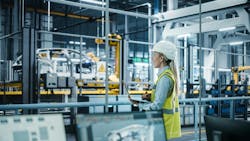5 challenges machine builders face on industry’s journey to autonomy
Key takeaways:
- Integrating autonomous technologies with legacy systems remains a major hurdle, requiring creative engineering solutions and careful cost-benefit analysis.
- Cybersecurity and operator training must evolve alongside increasing system intelligence.
- The high cost of advanced robotics and automation technology continues to limit adoption, but future affordability may accelerate broader deployment.
For every new technology at hand to aid autonomous facilities, there are many challenges to the lights-out factory or plant scenario. The history of manufacturing in this country is a challenge itself, as older facilities remain among the new shiny stars, and the challenges are many: infrastructure costs, hardware and software compatibility, cybersecurity practices and operator training.
1. Challenge: Building new machines for old factories, equipment and systems
The challenge with new technologies can be ensuring they are compatible with legacy equipment. “This can be challenging, often requiring significant modifications or replacements. Implementing new autonomous technologies requires substantial upfront costs for training, purchasing, setting up and integrating new systems,” says Tim Guelde, application engineering manager at Wauseon Machine.
The explosion of cloud and advanced computing technology has changed the face of manufacturing infrastructure. Software is surely replacing hardware in newer applications, but industry-wide change will take many years. “The challenge is machine builders will have to integrate software-driven intelligence into traditionally hardware-centric designs. Compatibility, cybersecurity risks and retraining engineering teams are major hurdles,” Andrew Borczak, industry marketing manager, Omron, says.
2. Challenge: Cybersecurity practices for connected, autonomous systems
Cybersecurity will be another challenge, where interconnected autonomous systems need to be fully protected in a changing security landscape. “Ensuring the security of interconnected autonomous systems is vital to protect against potential threats,” Guelde says.
Wide acceptance of artificial intelligence (AI) for processes like quality control will take some culture change in some organizations, and standardization of industrial protocols will help advance these solutions faster, says Borczak. He also echoes the security concerns. “Cybersecurity also remains a massive concern. Autonomous systems require hyper-connected infrastructure, which can increase vulnerability to cyber threats,” he adds.
To learn more about autonomous operations, read this other article about:
- current case studies—"Machine builders move toward autonomy"
3. Challenge: Production line changeover and increased product customization still largely rely on operators
Fully autonomous operations are rare in the manufacturing environment, as operators still solve issues like material jams or monitoring faults. Customized products and packaging, which is a growing trend for many manufacturers, requires more intervention for production line changeover.
“The requirement for changeovers due to mass customization makes a completely unattended manufacturing line more complicated,” says Pal Roach, senior principal industry consultant for oil and gas at Rockwell Automation. “Automatic changeover is still relatively unreliable, so a person sometimes needs to verify that the machine is set for the new product correctly.”
Get your subscription to Control Design’s daily newsletter.
4. Challenge: When operators are needed in the event of a failure, how do facilities train when systems otherwise run autonomously?
Even as we move toward autonomous operations, Sohail Nazari, global vice president and head of automation and digitalization for Andritz feed and biofuel division, says it’s important to remember that autonomy does not mean no humans. “Operations still need humans to take control when everything fails. And the question is: If the plant runs 99.9% of the time automatically, how are operators trained to take control?” he asks.
As an example, he points to the airline industry, where planes take off, cruise and land automatically. Pilots are only there to monitor and take over in the rare event of a failure. “So how do pilots practice landing a plane on water when they never get to do it in real life? They use flight simulators,” Nazari says.
Process industries can do that same thing in the face of a similar challenge as industries move toward autonomy. To keep operators alert and ready to intervene when needed and capable of understanding the systems, Andritz built the Operator Training Simulator specifically for the feed and pet food processing industry. “It’s a fully dynamic model of the plant—a complete digital twin—allowing operators to practice handling abnormal conditions when everything else fails,” he adds.
5. Challenge: All the new advanced technologies required for autonomous operations are costly
Upgrading plants and factories to the next level of automation will not come cheap. In addition to a premium price tag on many advanced technologies, these products can also require facility changes and other equipment upgrades. As with many new innovations, its price will come down in time as the market expands, and robotics is still finding its sure footing in the industrial market.
“I think that the biggest challenge with robotics at present is the cost. The hardware cost, it's hard to justify single-shift ROI on a piece of equipment,” says Greg Berguig, president of PAC Machinery. As the cost for robotics comes down, it will open the market for more manufacturers. Berguig says Asia is leading that robotics market and will likely eventually help lower the cost of a typical industrial setup from, on average, $15,000 to closer to $2,000. “Once we get there, then I think many more industries will be doing some really cool automation,” he adds.
Next steps for controls engineers:
- Assess existing machinery and plant infrastructure for compatibility with newer software-driven and autonomous technologies.
- Collaborate with IT and operations teams to strengthen cybersecurity protocols as machine connectivity increases.
- Explore simulation and digital-twin tools to build operator training programs that prepare staff for system failures and exception handling.
About the Author
Anna Townshend
Managing Editor
Anna Townshend has been a writer and journalist for 20 years. Previously, she was the editor of Marina Dock Age and International Dredging Review, until she joined Endeavor Business Media in June 2020. She is the managing editor of Control Design and Plant Services.

Leaders relevant to this article:

